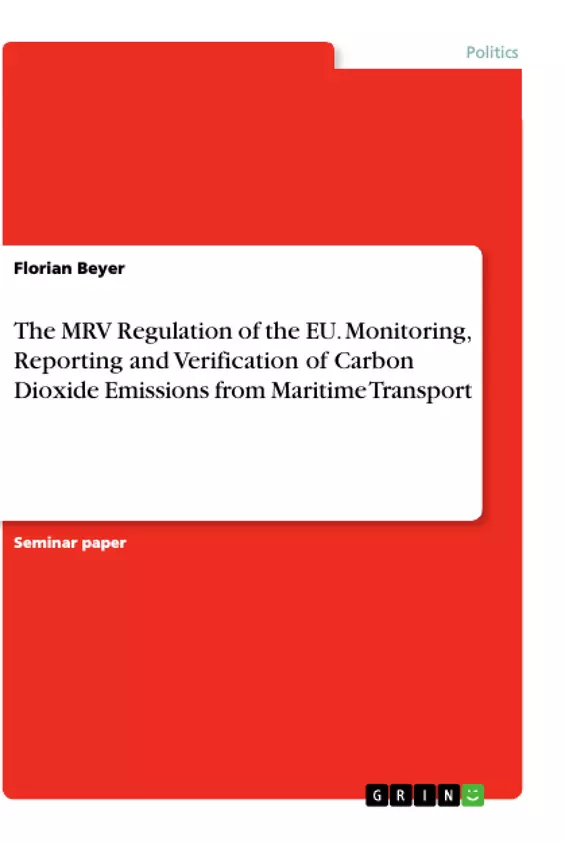This work examines the substance of the regulation 2015/757 on the monitoring, reporting and verification (MRV) of carbon dioxide emissions from maritime transport of the EU and its basis by the leading question: which regulatory interventions and creative compliance are to be seen behind the MRV regulation and what business case is possible? Therefore, the regulatory intervention in its public and private interest’s dimension is investigated. Moreover, the recent situation of the shipping branch and the ships’ ownership situation (owner-operator relation) are explained. A critical reflection of the regulation and an investigation for creative compliance is given. Concluding, potential business cases and the potential of the market are outlined.
Since July 1st 2015, the European Union’s (EU) regulation 2015/757 on the monitoring, reporting and verification (MRV) of carbon dioxide emissions from maritime transport became effective. According to EU 2015/757 art. 8, from 1 January 2018, ships voyaging to a port of call under the jurisdiction of a member state are obligated to apply to the regulation 2015/757 and must have a MRV system to report their CO2 emissions. By August 31th 2017, all shipping companies voyaging within the EU area are obligated to prepare a monitoring plan for each of their ships (EU 2015/757 art. 6).
Inhaltsverzeichnis (Table of Contents)
- Introduction
- Theoretical Background
- European Legislation
- Regulatory Intervention
- Creative Compliance
- Essentials of the Marine Industry
- The Branch's Recent Situation
- Ownership Situation
- Environmental Impact
- Investigation of the MRV Regulation
- Scope and Purpose
- Regulatory Intervention
- Creative Compliance
- Business Case based on a Regulation's Monitoring Method
- Conclusion and Critical Appraisal of the MRV Regulation
Zielsetzung und Themenschwerpunkte (Objectives and Key Themes)
This paper examines the European Union's (EU) regulation 2015/757 on the monitoring, reporting and verification (MRV) of carbon dioxide emissions from maritime transport. The paper explores the regulatory interventions and creative compliance behind the MRV regulation and assesses the potential business case that can be derived from it. The paper aims to provide a comprehensive understanding of the regulation's substance and its basis, considering the urgency of its requirements.
- Regulatory intervention in the shipping industry
- Creative compliance strategies in response to regulations
- Business opportunities and market potential stemming from the MRV regulation
- The impact of the MRV regulation on the shipping industry
- The role of environmental regulations in promoting sustainable practices
Zusammenfassung der Kapitel (Chapter Summaries)
The introduction provides background information on the MRV regulation and its implementation. It highlights the need for reducing CO2 emissions in the shipping industry and discusses the regulation's requirements.
The "Theoretical Background" chapter explores the legal framework surrounding the MRV regulation, including European legislation, regulatory intervention, and creative compliance strategies. This section sets the theoretical foundation for understanding the regulation's rationale and its potential impact on the shipping industry.
The "Essentials of the Marine Industry" chapter provides insights into the current state of the marine industry, covering key aspects like the recent situation of the branch, ownership structures, and the environmental impact of shipping activities.
The "Investigation of the MRV Regulation" chapter delves deeper into the scope and purpose of the regulation, analyzing the regulatory interventions implemented and exploring potential creative compliance strategies. It examines the regulation's impact on different stakeholders involved in the shipping industry.
The "Business Case based on a Regulation's Monitoring Method" chapter explores the potential business opportunities arising from the MRV regulation, focusing on the monitoring methods and their implications for the market.
The final chapter, "Conclusion and Critical Appraisal of the MRV Regulation," provides a critical analysis of the regulation's effectiveness and its potential to achieve its objectives. It explores the challenges and opportunities associated with implementing the regulation and its long-term impact on the shipping industry.
Schlüsselwörter (Keywords)
This study examines the MRV regulation for maritime transport, emphasizing regulatory interventions, creative compliance, and the potential business case. Key terms and concepts include: CO2 emissions, maritime transport, EU legislation, environmental regulations, sustainability, shipping industry, business case analysis, monitoring, reporting, verification, and creative compliance.
- Quote paper
- Florian Beyer (Author), 2017, The MRV Regulation of the EU. Monitoring, Reporting and Verification of Carbon Dioxide Emissions from Maritime Transport, Munich, GRIN Verlag, https://www.grin.com/document/536576



